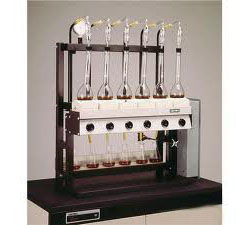In the
realm of analytical chemistry, the Kjeldahl method stands as a cornerstone
technique for determining the nitrogen content in organic compounds. Widely
employed in various industries including food, agriculture, and environmental
sciences, the Kjeldahl method relies on precise digestion and distillation
processes to accurately measure nitrogen levels. At the heart of this method
lies the Kjeldahl Digestion Distillation Unit
Manufacturer in India, a sophisticated
apparatus that plays a pivotal role in facilitating these critical processes.
Understanding the Kjeldahl Method
Named after its inventor, Johan Kjeldahl, the Kjeldahl
method involves several sequential steps to convert nitrogen-containing organic
compounds into ammonium sulfate, which can then be quantified. The process
begins with digestion, where the sample is heated in the presence of
concentrated sulfuric acid and a catalyst such as potassium sulfate. This step
breaks down the organic matter, releasing nitrogen in the form of ammonium
ions.
Following digestion, distillation is performed to
separate the ammonium ions from the digested sample. The distillation process
involves heating the digestate and collecting the distillate in a receiving
flask containing a known volume of boric acid solution. The ammonium ions react
with the boric acid to form ammonium borate, which can be titrated with a
standardized solution to determine the nitrogen content.
The Role of Kjeldahl Digestion Distillation Units
Central to the success of the Kjeldahl method is
the Kjeldahl Digestion Distillation
Unit, which streamlines the digestion and distillation processes
with precision and efficiency. These units typically consist of a digestion
block equipped with heating elements and a distillation assembly comprising a
condenser, receiving flask, and titration apparatus.
Key Features of Kjeldahl Digestion Distillation Units:
Temperature Control: Advanced
units offer precise temperature control to ensure optimal conditions for
digestion and distillation.
Safety Features: Built-in
safety features such as overheat protection and fume extraction systems
safeguard operators and prevent accidents.
Versatility: Units
may offer flexibility to accommodate different sample sizes and types, allowing
for versatile use across various applications.
Ease of Use: User-friendly
interfaces and intuitive controls make operation straightforward, even for
novice users.
Reliability: Robust
construction and high-quality materials ensure durability and long-term
reliability, minimizing downtime and maintenance requirements.
Applications of Kjeldahl Digestion Distillation Units
Kjeldahl Digestion Distillation Units find application
in a wide range of industries and research fields, including:
Food Analysis: Determination
of protein content in food products such as dairy, meat, and grains.
Agricultural Research: Analysis
of nitrogen levels in soil and plant tissues to assess nutrient availability
and crop health.
Environmental Monitoring: Measurement of nitrogen content in water samples
to evaluate pollution levels and ecological health.
Conclusion
In summary, Kjeldahl Digestion Distillation Units play a
crucial role in enabling the accurate and reliable determination of nitrogen
content using the Kjeldahl method. By automating and optimizing the digestion
and distillation processes, these units empower researchers, analysts, and
quality control professionals to obtain precise analytical results essential
for decision-making and compliance. As the demand for nitrogen analysis
continues to grow across various industries, the importance of Kjeldahl
Digestion Distillation Units in facilitating this fundamental technique remains
unwavering.
Kjeldahl Digestion Distillation
Unit Supplier & Manufacturer in India

Comments
Post a Comment